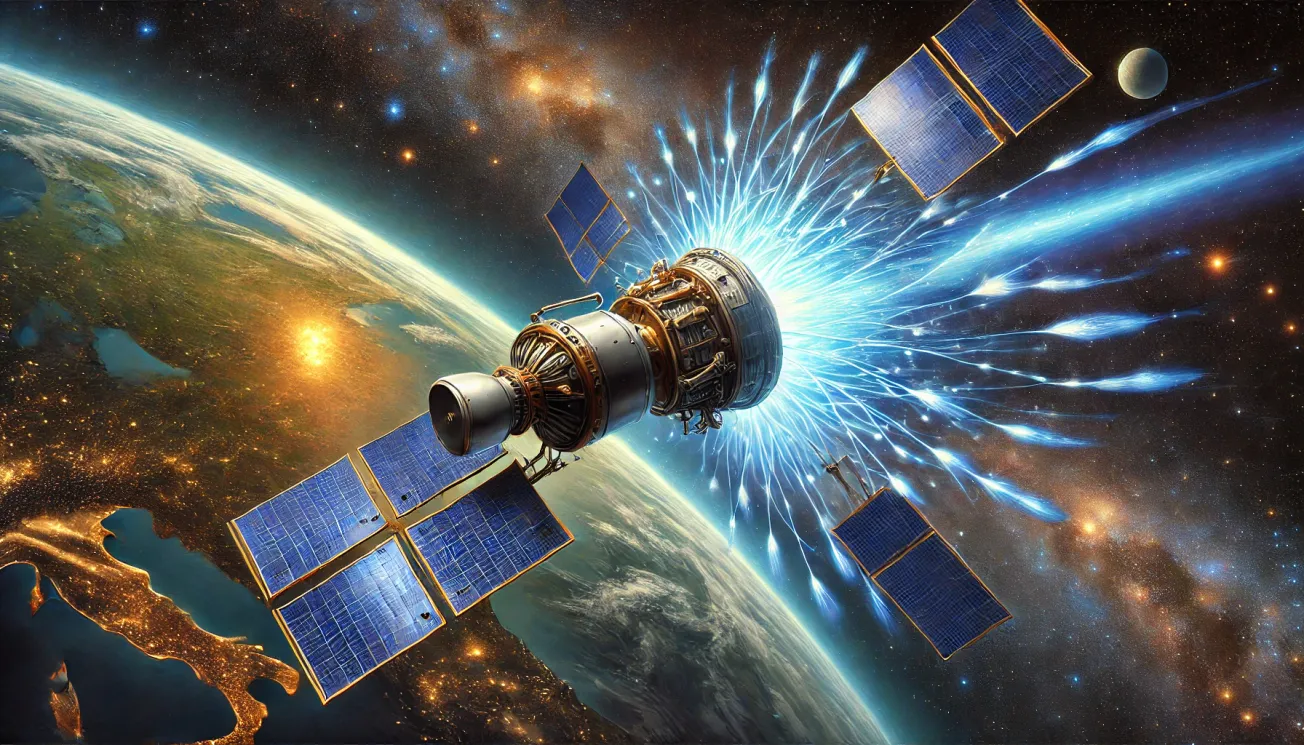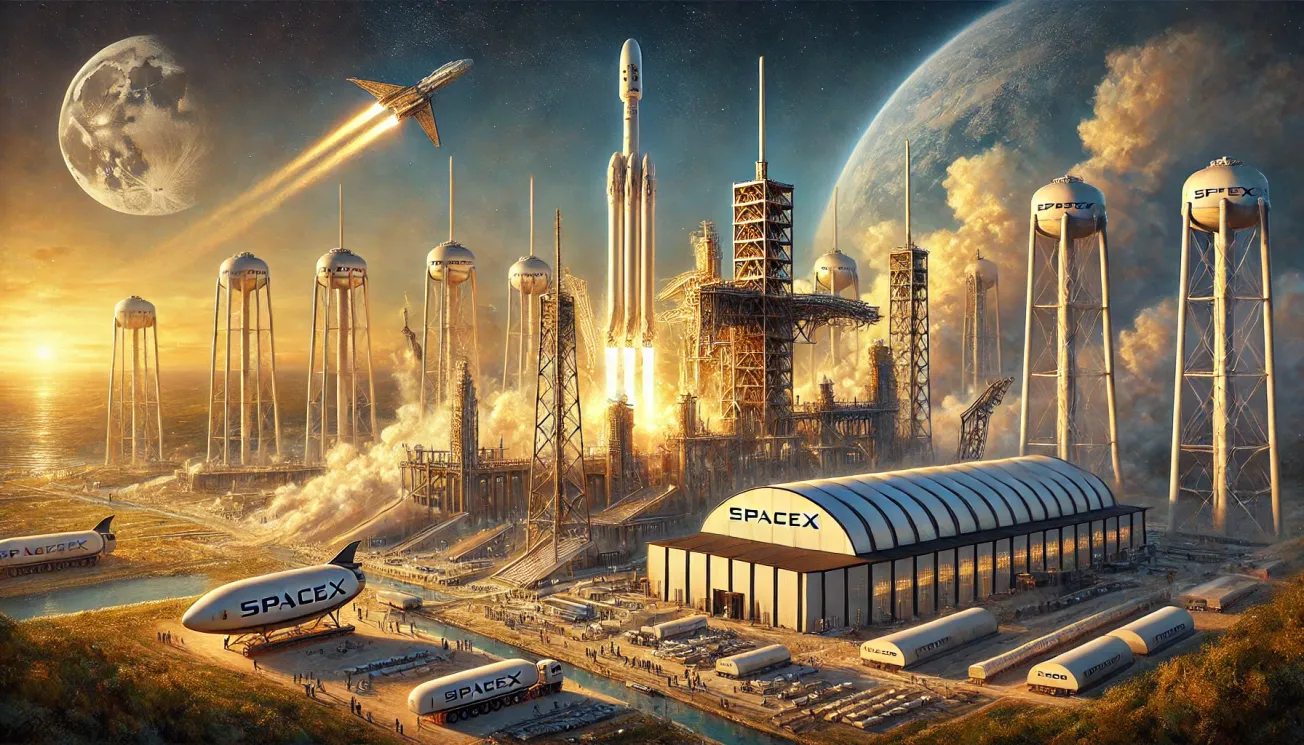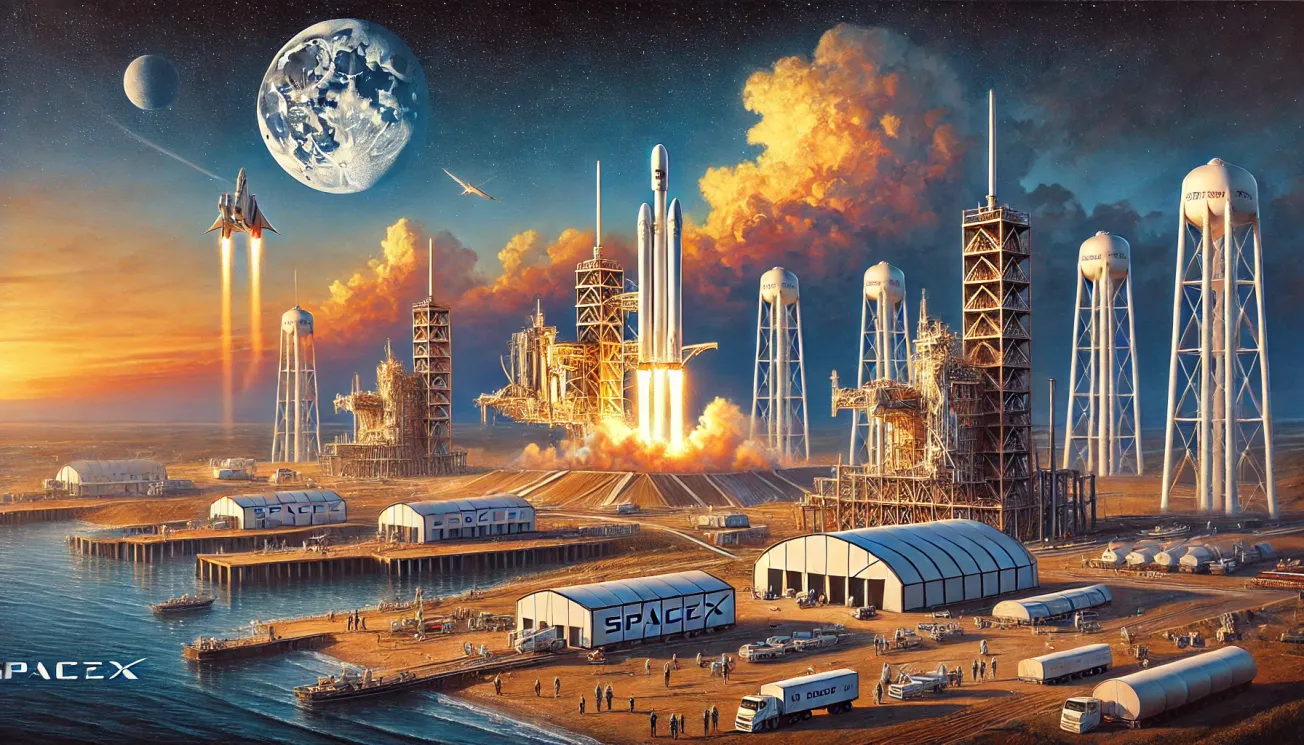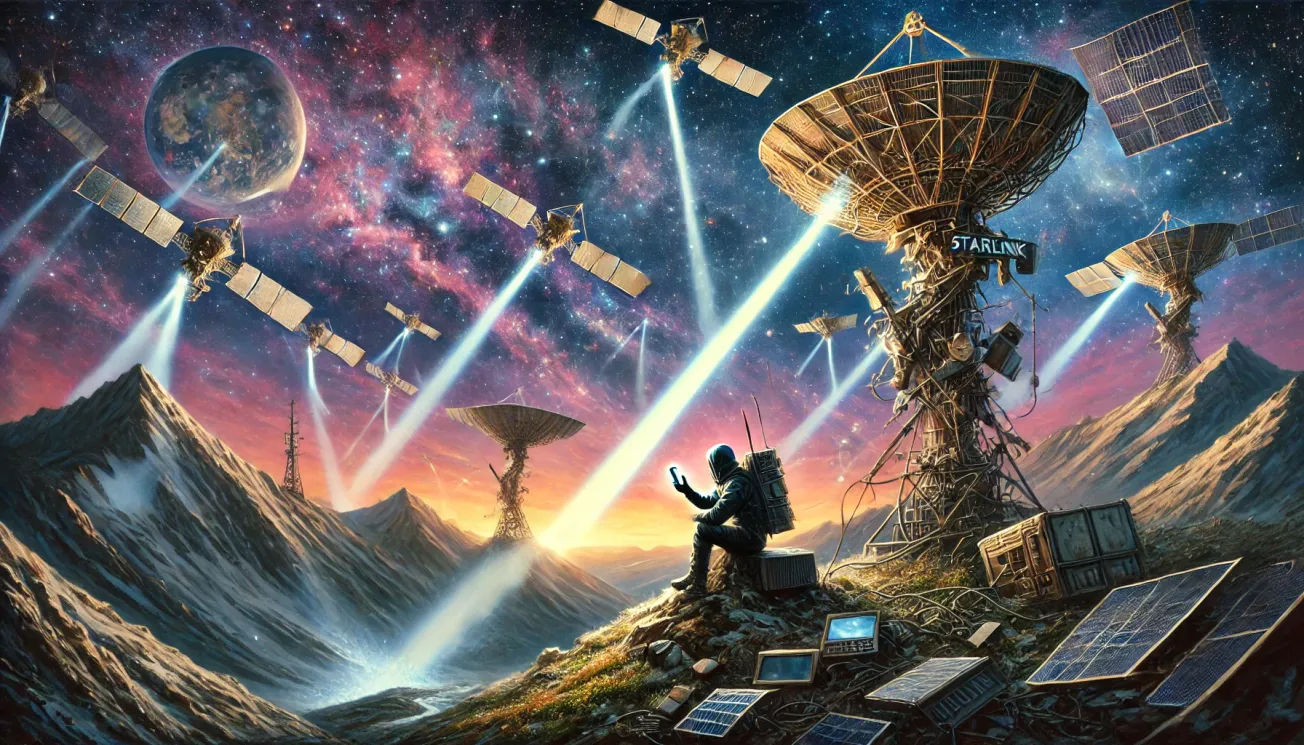Table of Contents
What Are Hall Effect Thrusters?
When it comes to keeping thousands of Starlink satellites in the right orbit, ensuring they don’t crash into each other, and eventually deorbiting them safely, traditional rocket engines just won’t cut it. That’s where Hall Effect Thrusters (HETs) come in—an advanced form of electric propulsion that enables precise, fuel-efficient adjustments in space.
Unlike chemical thrusters, which provide short bursts of powerful thrust, Hall Effect Thrusters operate by accelerating ionized gas using a magnetic field, generating a gentle but continuous push that can last for months or even years. This makes them perfect for small satellites that need to maneuver in low Earth orbit (LEO) without carrying heavy fuel tanks.
🚀 Why Are Hall Effect Thrusters Important for Starlink?
- They provide efficient propulsion to keep Starlink satellites in their designated orbital positions.
- They counteract atmospheric drag in LEO, ensuring satellites maintain altitude.
- They allow satellites to deorbit safely at the end of their operational life, reducing space debris.
- They operate using krypton gas, which is cheaper than xenon, making them more cost-effective for mass deployment.
📌 Did You Know? SpaceX's Starlink satellites are the first large-scale commercial spacecraft to use krypton-powered Hall Effect Thrusters instead of the more expensive xenon fuel!
This article explores how Hall Effect Thrusters work, why SpaceX uses them, and what the future holds for this groundbreaking propulsion technology.
How Hall Effect Thrusters Work: The Science Behind the Thrust
At first glance, Hall Effect Thrusters (HETs) don’t look like traditional rocket engines. There are no flames, no explosive fuel combustion, and no ear-splitting launches. Instead, these thrusters rely on electromagnetic forces to generate a steady and efficient push.
🛠 The Basic Principles of Hall Effect Thrusters
Hall Effect Thrusters work by ionizing a gas (such as krypton or xenon) and then accelerating those charged particles using a magnetic field to create thrust. The result is a highly efficient propulsion system that operates continuously for extended periods.
Here’s a step-by-step breakdown of how they generate thrust:
1️⃣ Gas Injection: The satellite releases a neutral gas (krypton in Starlink’s case) into the thruster.
2️⃣ Ionization Process: Electrons emitted from a cathode collide with gas atoms, knocking off electrons and creating positively charged ions.
3️⃣ Magnetic Containment: A strong radial magnetic field traps the electrons, forcing them into a circular motion—this creates the Hall Effect, which gives these thrusters their name.
4️⃣ Acceleration of Ions: The positively charged ions are pulled toward the exhaust by an electric field and ejected at high speeds (~15-50 km/s).
5️⃣ Thrust Generation: The ejected ions create a small but steady force, propelling the satellite forward.
6️⃣ Neutralization: To prevent the spacecraft from building up an electric charge, a neutralizer emits electrons to balance the charge of the expelled ions.
🚀 Key Features of Hall Effect Thrusters:
✅ Highly Efficient: They provide up to 10 times more impulse per kilogram of fuel compared to chemical thrusters.
✅ Continuous Operation: Unlike chemical rockets, which burn out quickly, Hall thrusters can run for months or even years using very little propellant.
✅ Ideal for Small Satellites: Their compact size and low weight make them perfect for constellations like Starlink.
🔬 Key Components of a Hall Effect Thruster
| Component | Function |
|---|---|
| Anode | Injects the gas (krypton or xenon). |
| Cathode (Electron Source) | Emits electrons to ionize the gas. |
| Magnetic Coils | Creates a magnetic field that traps electrons in a circular motion. |
| Electric Field Accelerators | Pulls positive ions toward the exhaust, generating thrust. |
| Neutralizer | Emits electrons to balance the charge of expelled ions. |
📌 Did You Know? Hall Effect Thrusters don’t require moving parts, making them extremely reliable and long-lasting compared to traditional propulsion systems!
Why SpaceX Uses Hall Effect Thrusters in Starlink Satellites
SpaceX’s Starlink satellite constellation is designed to provide global high-speed internet coverage, but to function effectively, these satellites need to stay in precise orbits, adjust their positions as needed, and safely deorbit at the end of their lifespan. Hall Effect Thrusters (HETs) provide the perfect solution for these challenges, offering efficient, low-cost, and reliable propulsion.
Here’s why SpaceX specifically chose Hall Effect Thrusters for Starlink satellites:
1️⃣ Orbital Maintenance & Drag Compensation
Starlink satellites orbit at low Earth orbit (LEO) (~550 km altitude), where there is still some atmospheric drag. Over time, this drag slows the satellites down, causing them to gradually descend.
🚀 How Hall Thrusters Help:
✅ Provide small, continuous thrust to counteract drag.
✅ Maintain precise orbital positioning to prevent collisions.
✅ Allow the satellites to perform small adjustments for optimal coverage.
📌 Did You Know? Without propulsion, a satellite in LEO would lose altitude and burn up within months due to atmospheric drag!
2️⃣ Deorbiting at End of Life (Space Debris Prevention)
With thousands of Starlink satellites in orbit, managing space debris is a critical concern. To ensure that old or malfunctioning satellites don’t become dangerous floating hazards, SpaceX designed Starlink satellites with the ability to deorbit themselves safely using Hall Effect Thrusters.
🔥 How It Works:
✅ At the end of a satellite’s lifespan, its Hall Thrusters fire opposite to its orbit, slowing it down.
✅ This causes the satellite to descend into the atmosphere, where it burns up upon reentry.
📌 Fun Fact: SpaceX claims that 95% of Starlink satellites will fully burn up in Earth’s atmosphere, ensuring minimal space junk!
3️⃣ Cost Savings: Krypton vs. Xenon Fuel
Most traditional Hall Effect Thrusters use xenon gas as a propellant. However, xenon is extremely expensive (~$3,000 per kg) and relatively scarce. Instead, SpaceX became the first major company to use krypton (~$500 per kg) in Hall Effect Thrusters.
💰 Why Krypton Instead of Xenon?
✅ Much cheaper than xenon, making it affordable for mass deployment.
✅ Still provides adequate thrust for Starlink’s orbital adjustments.
✅ Readily available, reducing supply chain limitations.
📌 Did You Know? Krypton-based Hall Thrusters are about 25% less efficient than xenon ones, but the cost savings make it a better choice for large-scale satellite constellations.
4️⃣ Compact and Lightweight Design
Starlink satellites are designed for mass production, meaning every component must be lightweight, compact, and cost-effective. Hall Effect Thrusters fit these criteria perfectly because they:
✅ Are small and lightweight compared to traditional thrusters.
✅ Don’t require moving parts, making them extremely durable.
✅ Can be stacked efficiently in the flat-packed design of Starlink satellites.
📌 Did You Know? Each Starlink satellite is roughly the size of a table and weighs about 260 kg—much smaller than most commercial satellites!
5️⃣ Reliability for Large-Scale Constellations
Unlike single-purpose deep-space probes, Starlink satellites operate in a massive interconnected network, meaning they must function autonomously with minimal failures. Hall Effect Thrusters provide:
✅ Long operational lifespans (designed for 5+ years of continuous use).
✅ Minimal wear and tear due to the lack of moving parts.
✅ Consistent performance, even in extreme space conditions.
📌 Did You Know? Some Hall Effect Thrusters have operated for over 10,000 hours in lab tests—longer than most satellites survive in orbit!
Why SpaceX’s Choice of Hall Effect Thrusters is a Game Changer
🚀 Key Takeaways:
✅ Hall Effect Thrusters keep Starlink satellites in orbit, counteracting atmospheric drag.
✅ They allow for controlled deorbiting, reducing space debris risks.
✅ Krypton-based thrusters significantly cut costs, making Starlink more affordable.
✅ They are compact, reliable, and efficient, ideal for a large-scale satellite constellation.
Krypton vs. Xenon: The Fuel Choice for Starlink Satellites
One of the most innovative decisions SpaceX made in developing the Starlink satellite network was switching from the traditional xenon propellant to krypton for its Hall Effect Thrusters (HETs).
🚀 Why does this matter?
- Most previous Hall Thrusters used xenon gas, a high-performance but extremely expensive propellant.
- SpaceX’s choice of krypton instead of xenon was an industry-first for a large-scale commercial satellite network.
- While krypton is slightly less efficient, it is far cheaper and more abundant, making it the best option for a massive fleet of satellites like Starlink.
1️⃣ Xenon: The Traditional Choice for Hall Effect Thrusters
💡 Xenon’s Advantages:
✅ High efficiency – More thrust per unit of fuel.
✅ Low ionization energy – Requires less power to operate.
✅ Used in deep-space missions – NASA’s Dawn spacecraft and ESA’s SMART-1 lunar probe both used xenon-fueled Hall Thrusters.
💰 Xenon’s Biggest Problem: Cost
- Xenon gas is extremely rare and costs ~$3,000 per kilogram.
- Its scarcity makes it unsuitable for large-scale satellite constellations like Starlink.
- Governments and space agencies are the primary users of xenon-based Hall Thrusters due to its high cost.
📌 Did You Know? A single NASA xenon-fueled ion thruster can run for over 7 years continuously, making it ideal for deep-space missions but impractical for mass-produced satellites.
2️⃣ Krypton: SpaceX’s Revolutionary Fuel Choice
🛠 Why SpaceX Chose Krypton:
✅ Much cheaper than xenon (~$500 per kg vs. $3,000 per kg).
✅ More widely available – No major supply chain concerns.
✅ Still works effectively in Hall Thrusters, despite slightly lower efficiency.
📌 Did You Know? Starlink satellites are the first large-scale spacecraft to use krypton-based Hall Thrusters, setting a new standard in the industry.
3️⃣ How Krypton Compares to Xenon in Performance
| Property | Xenon (Xe) | Krypton (Kr) |
|---|---|---|
| Cost per kg | ~$3,000 | ~$500 |
| Availability | Rare | More abundant |
| Thrust Efficiency | High | ~25% lower than xenon |
| Ionization Energy | Lower (easier to ionize) | Higher (requires more power) |
| Used in Starlink? | ❌ No | ✅ Yes |
📌 Key Trade-Off: Krypton thrusters are about 25% less efficient than xenon-based thrusters, but the massive cost savings make them the ideal choice for Starlink.
4️⃣ The Impact of Krypton on Starlink’s Hall Thruster Performance
Switching from xenon to krypton affects the performance of Starlink’s Hall Effect Thrusters in three main ways:
✅ Higher Power Draw – Krypton requires more ionization energy, meaning slightly higher power consumption.
✅ Slightly Lower Thrust – Krypton thrusters provide ~75% of the thrust output of xenon thrusters.
✅ Lower Cost = More Satellites – The cost savings allow SpaceX to mass-produce thousands of satellites affordably.
📌 Did You Know? If SpaceX had used xenon instead of krypton, Starlink satellites would have been far more expensive, slowing deployment and reducing profitability.
5️⃣ Future of Krypton-Fueled Hall Effect Thrusters
🚀 Will Krypton Remain the Standard for Starlink?
- Yes! Krypton has proven to be a cost-effective and scalable option for low-Earth orbit (LEO) satellites.
- Future Starlink iterations may improve krypton thruster efficiency with better plasma confinement and magnetic shielding.
- As more private companies enter the satellite industry, krypton may become the go-to fuel for commercial satellite propulsion.
🔭 Could SpaceX Use Xenon in the Future?
- Possibly! If xenon prices drop significantly, higher-efficiency Starlink models may switch back to xenon.
- For deep-space missions, SpaceX may still prefer xenon for long-duration, high-thrust applications.
📌 Did You Know? Krypton may eventually be used on future interplanetary missions if costs remain low and efficiency improves!
Conclusion: Why Krypton Was the Right Choice for Starlink
✅ Starlink is the first major commercial satellite network to use krypton-fueled Hall Effect Thrusters.
✅ Krypton is far cheaper than xenon, making Starlink’s mass production possible.
✅ While krypton thrusters are slightly less efficient, the cost savings outweigh the drawbacks.
Performance & Specifications of Starlink’s Hall Effect Thrusters
Now that we understand why SpaceX chose Hall Effect Thrusters and krypton fuel, let’s break down the actual performance and specifications of these propulsion systems.
Hall Effect Thrusters provide low but continuous thrust, making them ideal for Starlink satellites, which need constant small orbital corrections rather than high-power propulsion bursts.
1️⃣ Key Performance Metrics
Here’s a breakdown of the key performance specifications of the Starlink Hall Effect Thrusters:
| Performance Metric | Starlink Hall Thrusters |
|---|---|
| Thrust Output | ~5-10 millinewtons (mN) |
| Specific Impulse (ISP) | ~1,500-2,000 seconds |
| Power Consumption | ~1-2 kW per thruster |
| Fuel Type | Krypton gas |
| Fuel Capacity per Satellite | ~5-10 kg of krypton |
| Operational Lifespan | Designed for over 5 years |
| Number of Thrusters per Starlink Satellite | 4 |
📌 Did You Know? Starlink satellites use four Hall Effect Thrusters to adjust their altitude, perform station-keeping maneuvers, and safely deorbit at the end of their lifespan.
2️⃣ How Efficient Are Starlink’s Hall Effect Thrusters?
Hall Effect Thrusters are far more efficient than chemical rockets because they use electromagnetic acceleration instead of combustion. Their specific impulse (ISP)—which measures how efficiently they use fuel—is 1,500-2,000 seconds, compared to chemical thrusters, which have an ISP of around 300 seconds.
🚀 Why This Matters:
✅ 10x more fuel-efficient than traditional rocket engines.
✅ Can operate continuously for months or even years without needing refueling.
✅ Allows Starlink satellites to carry minimal fuel, making launches cheaper.
📌 Did You Know? A single Starlink satellite’s Hall Effect Thrusters can fire for thousands of hours over its lifetime, performing small but crucial adjustments.
3️⃣ How Long Do Starlink’s Hall Thrusters Last?
⏳ Lifespan & Durability:
- Hall Effect Thrusters are designed to operate for thousands of hours, far longer than traditional thrusters.
- Starlink’s krypton-based thrusters are expected to last over 5 years, aligning with the planned operational lifespan of each satellite.
- Because they have no moving parts, they are less prone to mechanical failures.
📌 Did You Know? Some laboratory Hall Thrusters have operated continuously for over 10,000 hours, proving their long-term reliability!
4️⃣ What Happens When a Starlink Satellite Runs Out of Fuel?
Once a Starlink satellite exhausts its krypton supply, it will no longer be able to adjust its orbit. SpaceX has planned for this by ensuring that:
✅ Satellites with depleted fuel automatically deorbit using their remaining thrust.
✅ If a satellite fails, it will gradually lose altitude and burn up in Earth’s atmosphere.
✅ This prevents defunct satellites from becoming space debris.
📌 Did You Know? Starlink satellites are designed so that 95% of their components will burn up completely upon reentry!
5️⃣ How Do Starlink Satellites Use Their Thrusters?
Each Starlink satellite has four Hall Effect Thrusters, which are used for different types of maneuvers:
🔹 Initial Orbit Raising – After deployment, thrusters help adjust the satellite’s position to its operational orbit (~550 km).
🔹 Station-Keeping – They perform small course corrections to maintain the proper orbit.
🔹 Collision Avoidance – If another object (such as space debris) is detected nearby, thrusters help adjust the satellite’s trajectory.
🔹 Deorbiting – At the end of its life, thrusters fire to slow the satellite down, causing it to fall into the atmosphere and burn up.
📌 Did You Know? Starlink satellites can autonomously avoid space debris by using their thrusters to move out of harm’s way.
Conclusion: Why Starlink’s Hall Effect Thrusters Are So Effective
🚀 Key Takeaways:
✅ Hall Effect Thrusters are highly efficient, allowing Starlink satellites to make small but continuous adjustments in orbit.
✅ They last for over 5 years, aligning with the lifespan of the satellites.
✅ Their krypton fuel choice makes them cheaper than traditional xenon thrusters.
✅ They enable safe deorbiting at the end of the satellite’s life, reducing space debris.
Hall Effect Thrusters vs. Other Satellite Propulsion Methods
Spacecraft propulsion systems come in many forms, each designed for specific missions, orbits, and fuel efficiency needs. While Hall Effect Thrusters (HETs) are an excellent choice for Starlink satellites, how do they compare to other types of propulsion used in space?
🚀 In this section, we’ll compare Hall Effect Thrusters to chemical rockets, ion thrusters, and other electric propulsion methods.
1️⃣ Hall Effect Thrusters vs. Chemical Rockets
Chemical rockets (the kind most people associate with spaceflight) generate high thrust by burning propellant in a controlled explosion. These are powerful but inefficient when it comes to long-term station-keeping in space.
| Feature | Hall Effect Thrusters | Chemical Rockets |
|---|---|---|
| Thrust Power | Low (~5-10 mN) | High (Thousands of Newtons) |
| Fuel Efficiency | High (ISP ~1,500-2,000s) | Low (ISP ~250-450s) |
| Duration of Use | Long-term, continuous | Short bursts, limited fuel |
| Ideal Use Case | Orbital adjustments & station-keeping | Launch, rapid orbital changes |
✅ Why Hall Effect Thrusters Win for Starlink:
- Chemical rockets burn through fuel too quickly to be practical for small satellites.
- HETs are 10x more fuel-efficient, allowing Starlink satellites to operate for years.
- Chemical rockets are necessary for launch but not ideal for fine-tuning satellite orbits.
📌 Did You Know? SpaceX’s Falcon 9 rocket uses chemical propulsion for launching Starlink satellites, but once in space, the satellites use electric propulsion (HETs) for orbital adjustments.
2️⃣ Hall Effect Thrusters vs. Ion Thrusters
Ion thrusters are another type of electric propulsion that also ionizes gas and expels it to generate thrust. However, there are key differences between ion thrusters and Hall Effect Thrusters.
| Feature | Hall Effect Thrusters | Ion Thrusters |
|---|---|---|
| Thrust Power | Low (~5-10 mN) | Very low (~1-5 mN) |
| Fuel Efficiency (ISP) | ~1,500-2,000s | ~3,000-10,000s |
| Fuel Type | Krypton or Xenon | Xenon |
| Complexity | Moderate | High |
| Common Uses | LEO satellites, station-keeping | Deep-space probes (e.g., NASA’s Dawn Mission) |
✅ Why Starlink Uses Hall Effect Thrusters Instead of Ion Thrusters:
- Ion thrusters are even more efficient but provide too little thrust for LEO satellites that need frequent adjustments.
- HETs strike a balance between efficiency and thrust power, making them better for small, mass-produced satellites like Starlink.
- Ion thrusters are ideal for deep-space missions but wouldn’t work well in Starlink’s orbital environment.
📌 Did You Know? NASA’s Deep Space 1 and the Dawn spacecraft used ion thrusters to travel across the solar system, reaching asteroids and dwarf planets.
3️⃣ Hall Effect Thrusters vs. Solar Sails & Other Propulsion Methods
There are also alternative propulsion methods that don’t require conventional fuel, such as solar sails and magnetoplasma thrusters.
| Feature | Hall Effect Thrusters | Solar Sails | Magnetoplasma Thrusters |
|---|---|---|---|
| Thrust Power | Low (~5-10 mN) | Extremely low (~µN) | Moderate |
| Fuel Type | Krypton | No fuel – uses sunlight | Plasma from ionized gas |
| Ideal Use Case | LEO satellites | Deep-space exploration | Research & experimental missions |
✅ Why Solar Sails & Magnetoplasma Thrusters Aren’t Used for Starlink:
- Solar sails require sunlight and take a long time to build momentum, making them impractical for frequent orbital adjustments.
- Magnetoplasma thrusters are experimental and not yet optimized for commercial satellites.
- Hall Effect Thrusters provide the best balance of power, efficiency, and affordability.
📌 Did You Know? NASA’s LightSail 2 mission successfully used solar sails to raise its orbit using only sunlight!
4️⃣ Why Hall Effect Thrusters Are the Best Choice for Starlink Satellites
🚀 Hall Effect Thrusters were chosen because they offer the best combination of:
✅ High fuel efficiency (enabling long operational lifespans).
✅ Enough thrust power to maintain precise orbits.
✅ Low cost and compact size, making them ideal for mass-produced satellites.
📌 Final Verdict: Hall Effect Thrusters outperform other propulsion types for large-scale satellite constellations like Starlink.
Challenges & Limitations of Hall Effect Thrusters
While Hall Effect Thrusters (HETs) are a game-changer for satellite propulsion, they are not without drawbacks. Despite their high efficiency and long lifespan, there are certain limitations that SpaceX and other satellite operators must account for.
1️⃣ Low Thrust Output: Slow but Steady
Hall Effect Thrusters produce very low thrust—typically around 5-10 millinewtons (mN). This is thousands of times weaker than the thrust produced by chemical rockets.
🚀 Why This Is a Challenge:
- They cannot be used for fast orbital changes or major trajectory adjustments.
- Satellites must fire their thrusters for weeks or months to significantly alter their position.
- They wouldn’t work for crewed spaceflight since human missions require fast maneuvers.
📌 Did You Know? If a Hall Effect Thruster were used to launch a spacecraft from Earth, it would take several months just to clear the atmosphere!
✅ How SpaceX Overcomes This:
- Starlink satellites are deployed into a nearly correct orbit, so they only need minor adjustments.
- Instead of quick bursts, thrusters fire continuously over time to make slow, precise orbital changes.
2️⃣ High Power Requirements: Draining the Battery
Hall Effect Thrusters require electrical power to operate, typically around 1-2 kW per thruster on Starlink satellites.
🔋 Why This Is a Challenge:
- Requires large solar panels to generate enough power.
- Can limit power available for other satellite functions (such as data transmission).
- Cannot be used in low-power spacecraft that don’t have large energy reserves.
📌 Did You Know? Some deep-space probes using ion or Hall Thrusters rely on nuclear power sources instead of solar panels to generate enough electricity.
✅ How SpaceX Overcomes This:
- Starlink satellites have large solar arrays to provide adequate power.
- The satellites balance power usage between propulsion, communication, and computing.
- Future versions may improve power efficiency to reduce energy consumption.
3️⃣ Krypton’s Lower Efficiency Compared to Xenon
SpaceX chose krypton over xenon for cost reasons, but krypton isn’t as efficient as xenon when used in Hall Effect Thrusters.
🚀 Why This Is a Challenge:
- Krypton produces about 25% less thrust per unit of fuel compared to xenon.
- It requires more power to ionize, slightly increasing energy consumption.
- The satellites need to carry more krypton than they would xenon for the same level of performance.
📌 Did You Know? NASA’s most advanced xenon ion thrusters have an ISP of up to 10,000 seconds, compared to krypton Hall thrusters at 1,500-2,000 seconds.
✅ How SpaceX Overcomes This:
- The cost savings far outweigh the efficiency loss, making Starlink deployment feasible.
- Future Hall Thruster improvements may boost krypton efficiency closer to xenon levels.
- Scaling up the Starlink constellation means even if some satellites need more corrections, the overall network remains stable.
4️⃣ Erosion & Longevity Concerns
Over time, the inner walls of a Hall Effect Thruster erode due to plasma bombardment. This is a natural wear-and-tear process that limits the lifespan of the thruster.
⚡ Why This Is a Challenge:
- Thruster erosion reduces efficiency over time.
- Could lead to shorter operational lifespans for satellites.
- More frequent replacements increase long-term costs.
📌 Did You Know? Some next-generation Hall Thrusters use magnetic shielding to reduce erosion, extending their lifespan significantly.
✅ How SpaceX Overcomes This:
- Starlink satellites are designed for 5-7 years of operation, so their Hall Thrusters don’t need to last decades.
- The company can replace old satellites with new ones, continuously improving the network.
- Future upgrades to Hall Thrusters may include improved shielding to reduce erosion effects.
5️⃣ Space Debris Risks & Deorbiting Challenges
If a satellite loses power or becomes uncontrollable, its thrusters can no longer function, and it could become space debris.
🚀 Why This Is a Challenge:
- Non-functional satellites pose collision risks for other spacecraft.
- Thrusters must be reliable enough to ensure proper deorbiting.
- Increasing numbers of satellites in LEO increase congestion concerns.
📌 Did You Know? There are over 4,000 active Starlink satellites in orbit, with plans for tens of thousands more. Managing space debris is a major concern for the future of spaceflight.
✅ How SpaceX Overcomes This:
- Each Starlink satellite is designed to safely deorbit when it reaches the end of its life.
- Thrusters fire in a controlled burn to lower the satellite’s altitude until it reenters the atmosphere and burns up.
- In the rare case of total failure, orbital decay naturally causes the satellite to fall back to Earth within a few years.
The Pros and Cons of Hall Effect Thrusters
🚀 Hall Effect Thrusters are an incredible technology, but they come with limitations that require careful engineering solutions.
📌 Key Takeaways:
✅ Hall Thrusters produce low thrust, but their efficiency makes them ideal for small satellites.
✅ They require significant electrical power, but Starlink’s solar panels handle this demand.
✅ Krypton is cheaper than xenon but slightly less efficient—SpaceX traded some performance for affordability.
✅ Erosion over time could be an issue, but new shielding technologies may solve this problem.
✅ Proper deorbiting plans ensure that satellites don’t become dangerous space debris.
🚀 Despite these challenges, Hall Effect Thrusters remain the best propulsion choice for Starlink and similar satellite networks.
Future Developments in Hall Effect Thrusters
Hall Effect Thrusters (HETs) have already revolutionized space propulsion, but research is ongoing to improve their efficiency, longevity, and power for future missions. As SpaceX, NASA, and other space agencies push toward larger constellations, interplanetary missions, and even human spaceflight, next-generation Hall Thrusters will play an even bigger role.
🚀 In this section, we’ll explore the most exciting advancements in Hall Thruster technology and what they mean for the future of space travel.
1️⃣ Magnetic Shielding: Extending Thruster Lifespans
One of the biggest challenges of Hall Effect Thrusters is erosion of internal components due to constant plasma bombardment. To solve this, engineers are developing magnetically shielded Hall Thrusters, which use stronger magnetic fields to protect thruster walls from ion erosion.
🔬 Why This Matters:
✅ Can increase thruster lifespan from 5-7 years to 10+ years.
✅ Reduces maintenance and replacement costs for long-duration missions.
✅ Could allow Starlink satellites to stay operational for much longer, reducing the need for frequent satellite launches.
📌 Did You Know? NASA’s X3 Hall Thruster, developed by the University of Michigan, uses magnetic shielding and three ionization channels, making it one of the most powerful Hall Thrusters ever tested!
2️⃣ Higher Power, Higher Thrust: Scaling Up for Future Missions
Hall Thrusters are currently limited by power availability, but future satellites and spacecraft will carry larger solar arrays and nuclear-powered energy sources, allowing them to operate higher-power Hall Thrusters.
🚀 How Next-Gen Hall Thrusters Will Improve:
✅ More powerful thrusters (10-100x current Starlink levels) for larger spacecraft.
✅ Higher thrust levels could allow human-rated spacecraft to use Hall Thrusters.
✅ Deep-space exploration missions could use high-power Hall Thrusters to travel beyond Mars.
📌 Did You Know? The NASA Psyche Mission, set to explore a metallic asteroid, will use a solar-powered Hall Thruster system for interplanetary travel.
3️⃣ Advanced Propellants: Beyond Krypton and Xenon
Currently, Hall Effect Thrusters primarily use xenon (high efficiency) or krypton (cheaper alternative), but researchers are exploring new propellant types that could offer even better performance.
🔬 Future Fuel Options:
- Argon – More abundant and cheaper than both xenon and krypton.
- Iodine – Can be stored as a solid, reducing spacecraft weight and storage issues.
- Bismuth & Magnesium – High-efficiency alternatives under laboratory testing.
📌 Did You Know? A French company (ThrustMe) has already tested an iodine-fueled Hall Thruster in space, proving it can work as an alternative to traditional noble gases.
✅ Why This Matters for Starlink:
- Could make future satellites even cheaper to produce.
- May allow higher efficiency and longer-lasting propulsion.
- Reduces dependency on noble gases, which are expensive and sometimes hard to source.
4️⃣ Hall Thrusters for Crewed Space Missions?
Right now, Hall Effect Thrusters are too weak for human spaceflight, but higher-power models could change that.
🚀 How Hall Thrusters Could Impact Future Crewed Space Travel:
✅ Mars Missions: A spacecraft using high-power Hall Thrusters could reach Mars in half the time of chemical rockets while using far less fuel.
✅ Lunar Cargo Transport: Hall Thrusters could be used for cargo deliveries between Earth and the Moon.
✅ Space Stations & Habitats: Future space stations could use Hall Thrusters for station-keeping rather than relying on chemical propellant.
📌 Did You Know? NASA’s NextSTEP Program is developing megawatt-class Hall Thrusters that could power human missions to Mars!
5️⃣ Integration with AI & Autonomous Systems
As Hall Thrusters become more widely used, they will likely be integrated with AI-driven navigation systems to allow spacecraft to make independent course corrections.
🤖 How AI Will Improve Hall Thruster Performance:
✅ Self-optimizing thrust algorithms to adjust fuel usage in real-time.
✅ Autonomous course corrections to dodge space debris without human intervention.
✅ Machine learning predictions to extend thruster lifespan by optimizing power cycles.
📌 Did You Know? Starlink satellites already autonomously adjust their orbits to avoid collisions, and future AI integration could make their Hall Thrusters even smarter.
6️⃣ The Future of Hall Thrusters in Space Exploration
As propulsion technology advances, Hall Effect Thrusters are expected to become even more powerful, efficient, and widely used across many different space missions.
🚀 What’s Coming Next?
✅ Megawatt-Class Hall Thrusters for Mars and Beyond
✅ Space Stations and Lunar Bases Using Hall Thrusters for Orbital Adjustments
✅ Large-Scale AI-Managed Constellations with Smart Propulsion Systems
✅ New Propellants That Reduce Costs and Improve Performance
📌 Final Thought: Hall Effect Thrusters have already changed how satellites navigate space, but in the future, they could help humans reach Mars, build lunar habitats, and push deep-space exploration further than ever before.
Conclusion: Why Hall Effect Thrusters Are the Future of Satellite Propulsion
🚀 Key Takeaways:
✅ Hall Thrusters will last longer with magnetic shielding technology.
✅ Higher-power models will allow for deep-space missions and larger spacecraft.
✅ New propellants like iodine and argon may replace krypton and xenon in the future.
✅ AI-driven navigation will make Hall Thruster satellites fully autonomous.
✅ One day, human missions to Mars could be powered by next-generation Hall Thrusters!










